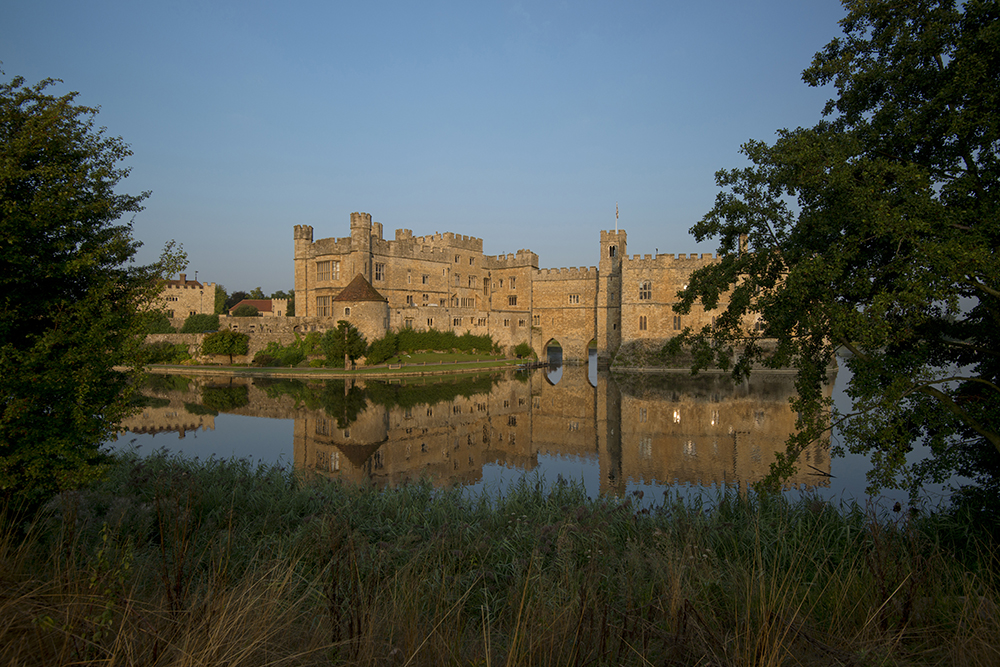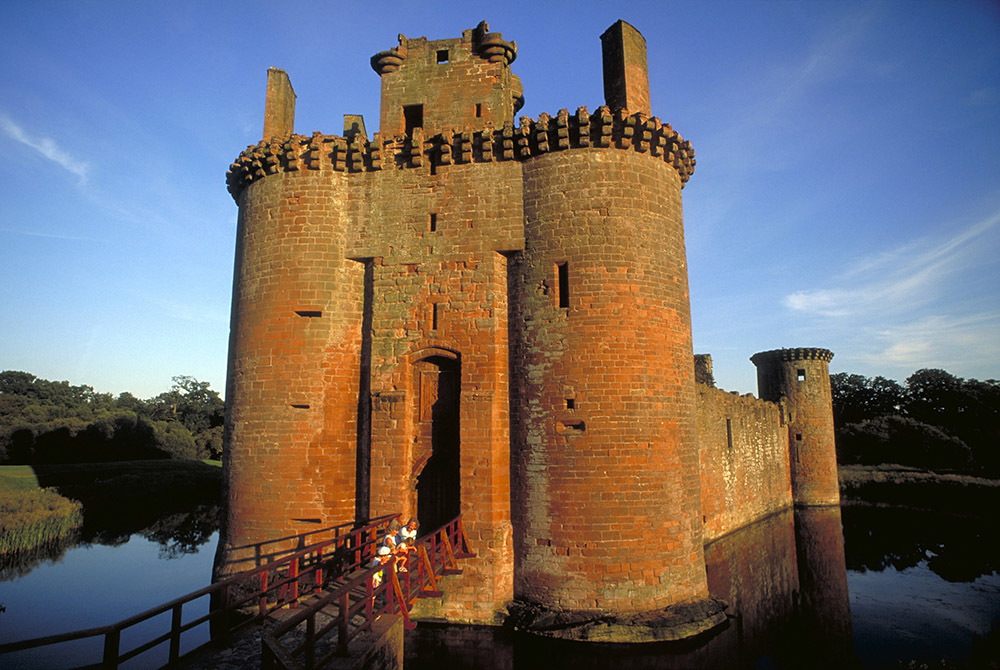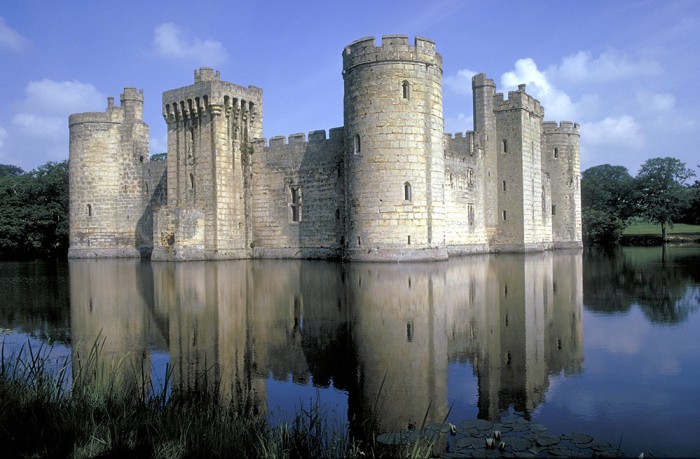Moats and majesty
Epic and impossibly romantic, Britain’s moated castles conjure images of valiant knights in shining armour, but the serene waters that surround them belie a tumultuous history…
Bodiam Castle, East Sussex
This spectacular, late medieval castle in East Sussex was built in the mid 1380s and its external appearance remains much the same today as it did then. The complete walls and ramparts provide a dramatic addition to the surrounding scenery, allowing visitors to be transported back in time to when the castle was used as a stronghold as well as a home.
As you make your way across the bridge to the gatehouse, you will be able to see the unicorn crest of Sir Edward Dalyngrigge above the imposing studded door and original, wooden portcullis. It was Sir Edward who built the castle, replacing his manor house in order to help defend against the French during the Hundred Years War. In reality it was more likely designed to convey its owner’s wealth than as a serious fortification.
Following Dalyngrigge’s death the castle fell into a state of repair before a series of wealthy benefactors set about saving it, including Lord Curzon, the Viceroy of India, who bought the castle in 1916 and financed many essential repairs. He bequeathed the castle to the National Trust who took ownership in 1926.
As you pass through the gatehouse, make sure you remember to turn your gaze skywards in order to admire the vaulted ceiling. The ceiling has a cross pattern of round openings, charmingly referred to as ‘murder holes’ as they would have been used to help defend against attackers by pouring boiling liquid through them onto anyone unfortunate enough to be standing below.
There’s plenty to explore once inside the four walls, (keep an eye out for the ancient graffiti carved into the stone). The chapel window, old fireplaces and passageway can still be seen, providing hints and clues as to what the interior would have looked like when it was still intact. Once you’ve finished the castle’s confines, snake your way up the spiral staircases leading to the tops of the towers to see the views of the Rother Valley.
Leeds Castle, Kent

Set on two islands on the River Len in the heart of Kent, Leeds Castle is a striking medieval fortress and a former favourite of Henry VIII, who once brought along his entire court while on the way to a tournament in France with Catherine of Aragon in 1520. After being in royal ownership since 1278, it was Henry’s son, King Edward VI, who gifted the castle to one of his father’s courtiers, placing the castle into private ownership, where it would become the home of several wealthy families over the years, including the Fairfax and Culpeper families.
Today the castle is owned by the Leeds Castle Foundation, who have cared for the property since 1974 when it was gifted to them by the castle’s last private owner, Lady Baillie. After acquiring the property in 1926, Lady Baillie soon stamped her mark on the castle, employing some of the best architects and designers of the time, who were responsible for creating much of the exquisite interiors still viewable today. Lady Baillie also greatly added to the castle’s grounds in the 1950s with the introduction of a golf course and several aviaries, which remain popular attractions today.
Since passing into the hands of the Leeds Castle Foundation, the castle continues to be a hive of activity, attracting over 10 million visitors who regularly opt to stay in the beautiful bedrooms, or rent out the three holiday cottages within the grounds.
It’s not surprising that the castle attracts so many visitors as there is plenty to do while there, whether it’s cycling around the grounds, taking in a game of golf or enjoying a meal at the castle’s restaurant. You can even take to the skies for some amazing aerial views of the castle and the surrounding area in one of the hot air balloons that regularly take off from the grounds of the property between 1 April and 1 November each year.
Caerlaverock Castle, Dumfries, Scotland

Teetering on the border between Scotland and England, Caerlaverock Castle has had a particularly turbulent history and was often swept up in territorial disputes. However, the castle’s unusual triangular design helped its occupiers to fend off English onslaughts for 400 years, with varying amounts of success. On 1 July 1300, Edward I ordered his army to strike against the castle, but the ensuing battle only lasted for two days before the stronghold was overrun. In 1640, the last siege against the castle lasted for over three months before culminating in the south wall being torn down and the castle being stripped of all of its fixtures and fittings.
The wall was never rebuilt, leaving the castle defenceless against any further attacks, and today its ragged remains allow visitors approaching the castle a glimpse of what lies in store. Standing on the bank of the moat across from the castle, it is possible to see past the jagged outline of the fallen south wall to the impressive, ornate Nithsdale Lodgings, nestled against the rich, earth-coloured, red sandstone walls of the medieval fortress. The lodgings were built by the 1st Earl of Nithsdale in the 1630s during a period of peace and was beautifully embellished with renaissance stone carvings.
Despite its violent past, the scene at Caerlaverock is now one of calm and tranquillity, as visitors wander around displays of medieval style implements of siege warfare, learning about the castle’s history, or taking a walk through the surrounding woodlands to visit the site of an earlier castle.
Scotney Castle, Kent
Visitors to Scotney are able to view the 14th-century castle as well as the 19th-century house, tucked away within the folds of the gorgeous Kent countryside. Built as a fortified house, the castle was constructed around 1378 by Roger Ashburnham. Originally it would have had round towers at each corner, but today the Ashburnham tower is the only one to have survived the test of time. The estate that surrounds the medieval castle and moat saw further development during the Victorian era, with the addition of an Elizabethan-style house designed by Anthony Salvin. Around 1837 the house was added to the site further up the hill for Edward Hussey III.
The two buildings are set within a 780-acre estate and are surrounded by fields and spectacular gardens, where white wisteria drapes over the old ruins in a cascade of colour. Over the years the estate’s gardens have been improved and expanded by several of its owners and have been voted among the top 10 in England for their glorious displays.
Surrounded by such beautiful settings, it’s no wonder Hussey was inspired to paint numerous watercolours of the property. His grandson, Christopher, inherited the estate in 1952 and he and his wife worked on creating even more drama and colour to the surrounding gardens. Christopher died in 1970 and left the estate to the National Trust which continues to care for the property and its grounds.
Herstmonceux Castle, East Sussex
Dating from 1441, Herstmonceux Castle has a claim to fame as one of the first major brick buildings to be built. Sir Roger Fiennes, treasurer to the household of Henry VI, was the man behind the castle’s construction, which was designed as a luxurious place of residence rather than a line of defence.
The castle is set within beautiful Elizabethan grounds and parkland in East Sussex, with gardens bursting with the scent and colour of roses, rhododendrons and herbaceous borders. There is plenty to discover as you wander around the grounds, including peaceful lakes polka dotted with lilies, woodland trails and a 1930s folly in the form of a miniature, Georgian-style, two-storey house.
The castle underwent major renovations in 1911 after the property was bought by Lt Col Claude Lowther, who employed an army of local craftsmen to carry out essential building work. The renovation included the addition of pieces of fine woodwork and panelling which were remnants from other grand houses across England.
The property is now owned by Queen’s University of Canada, but the castle’s current appearance remains largely as Lt Col Lowther designed it. Queen’s University acquired the castle in 1993 and continue to use it as an international study centre, allowing students from around the world to share in the castle’s history, while enjoying the grand architecture and beautiful surroundings. Although the castle is not generally open to the public it is possible to arrange guided tours of the property.




